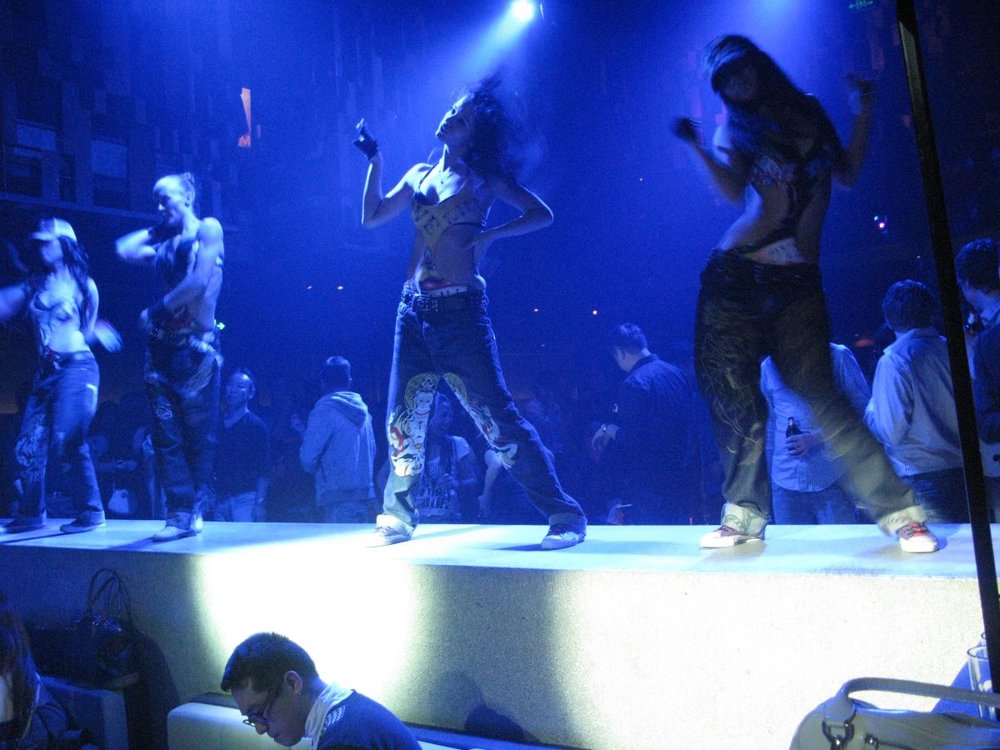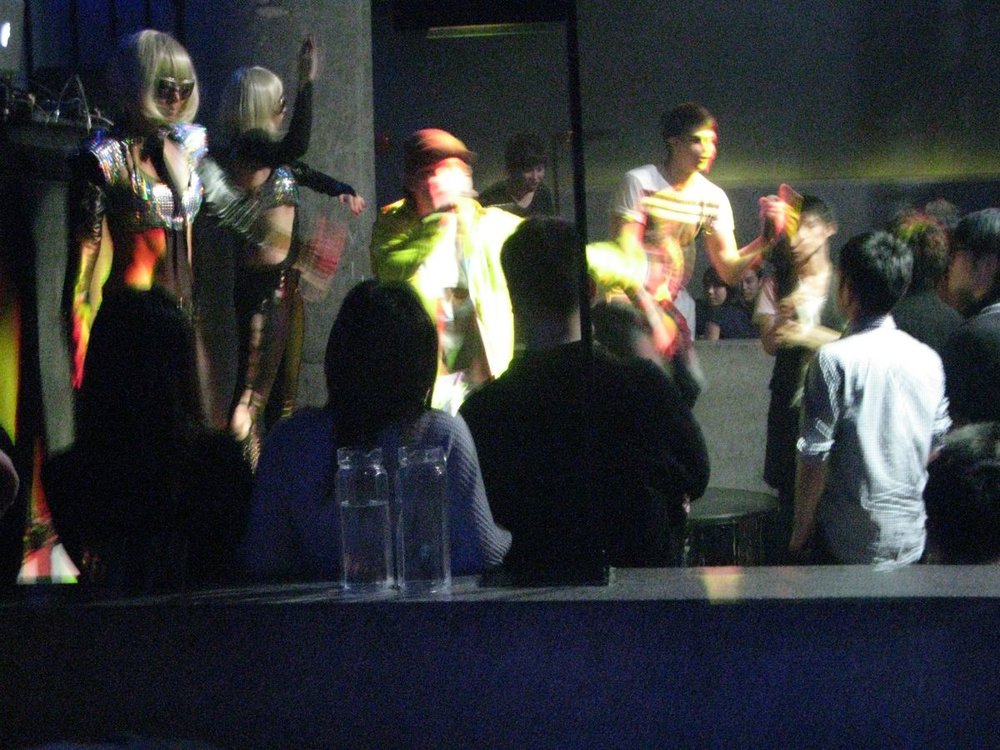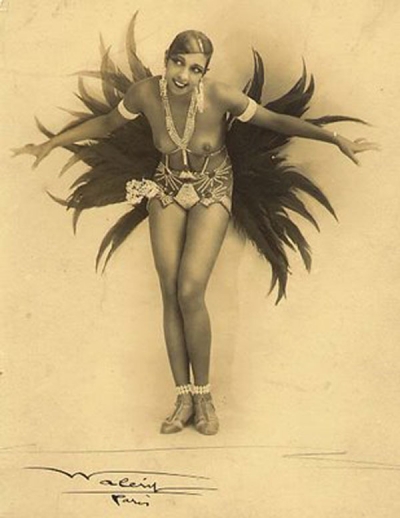Astute readers of my blog (if there are any) may recall an entry I posted a few years ago about a visit to the Muse Nightclub in Shanghai. That was back in 2007. Today there are three Muses operating in the city. In our book Shanghai Nightscapes: Nightlife, Globalization, and Sexuality in the Chinese Metropolis 1920-2010 (currently under review by a major university press) James Farrer and I write about the city's nightlife over the past century and how nightlife has come to play a central and defining role in the cosmopolitan identity of the city. While we don't have time or space to cover all the multifarious twists and turns that nightlife has made over the past few years of explosive growth, nor all the clubs that have ebbed and flowed over the city's nighttime landscape, Muse is definitely central to our story of nightlife's revival since the 1990s. In the book we discuss the Muse epic in some detail--I'll leave it at that for now, not wanting to spoil a good story.
Last weekend, I paid my first visit to the new Muse 2. The former Muse 2 was located on the sixth floor of Plaza 66 on Nanjing West Road. It was a favorite bastion of young clubbers and boasted a prime location in the city. But according to my key informant Big T (also known as Beijing Tony or just BT), the club decided to switch locations after a certain male clubber launched himself from the club's entrance into the atrium of the building and plummeted six floors to his death. I haven't heard any other accounts or corroborations of this story but would appreciate if anybody else knows something about this. Otherwise I take it as one of many rumors and myths swirling around the city's nightlife scene. In any case, the club did move last year to a new location in the growing clubbing matrix around the area of Xintiandi.
On Saturday night a group of us gathered together to celebrate the visit of our old and dear friend KK, who was back in town for a short spell. After a dinner at Xin Jishi, a popular Shanghainese restaurant in the Xintiandi complex, BT took us over to the Muse 2 nightclub to continue the celebration in usual BT style. He had booked us a prime spot near between the dance floor and the bar, where we spent most of the night. Our group consisted of four couples (unusually, my wife joined us and had a blast). Our lounge table was well-attended by service people who hovered about waiting to replace empty bottles. In typical Chinese-clubbing style, we hung around chatting (yelling at the top of our lungs is more like it, since the music got deafening and one of the speakers was located right at the edge of our table), playing dice games and dancing around the table, and snapping endless photos of each other, most of which will never see the light of day beyond the screen of my desktop computer.
Once in a while I got up to check out the scene and drifted into the sea of clubbers that had gathered in the laser-light saturated darkness of the club. As usual, most of the foreigners were "ghettoized" in the bar area, while the tables and lounges were occupied by Chinese clubbers who had booked them in advance. There were two elevated stages, one at the far edge of the dance floor and one in the middle of the club. We were seated on the main floor. In a style typical of clubs in Shanghai since the 1920s, there was a second floor overlooking the main floor with private baofang rooms where elite clubbers could look over the crowd. Such an assemblage is also reminiscent in some respects of opera houses in 18th century Europe or, more tellingly perhaps given the location, of kabuki theaters in Edo Japan.

Every now and then, groups of stage performers mounted the stage and performed exotic song-and-dance routines. Most of these performers were foreigners, and their features were exoticized by their dress and hairstyles. One blond-haired couple performed an acrobatic dance routine with some gymnastics thrown in for good measure (the man held the girl's legs while she performed cartwheels). Later that evening some girls got on stage in skimpy costumes and did a loosely choreographed dance routine, their bodies moving roughly in unison to the beat. There was also a hip-hop routine on the other stage at the edge of the dance floor. The floor guards prevented me from taking photos but I did capture a few clandestine ones, one of which might go into our book in a section where we talk about how foreigners are sexualized in the city's nightlife scene.

The presence of foreigners performing sexy acts onstage for the delectation of Chinese clubbers is very common now in the city's nightlife scene, and reminiscent of the sorts of stage performances that were taking place in nightclubs in the city during the "golden age" 1930s, such as the famed Paramount ballroom. Then, the colonial racial hierarchy so painstakingly maintained by the British (less so by the French and Americans, the other two groups that ruled the city back in the Treaty Port era) was being flouted by the presence of Russians who had arrived destitute and stateless after their country had experienced Lenin's revolution in 1917. Since Russian women were willing to sleep with Chinese men for money, and Russian men to serve as the bodyguards of wealthy Chinese, their service to the "yellow race" was a direct affront to the racial colonial order of the day. In the 1920s, as my first book Shanghai's Dancing World describes, newspapers were full of scathing articles about these Russians. But by the 1930s, their presence was no longer as controversial and they had been accepted as part of the exotic aura of the city.

One vast difference between today's nightlife culture and that of the 1920s and '30s is that there are no longer any major taboos about white people fraternizing with Asians. Back in the 1920s and '30s interracial dating in Shanghai was very rare and interracial marriage even moreso. Eurasians were considered a social pathology by some, and the practice of interracial breeding was labeled "miscegenation." It was considered low-class for white foreign men to indulge their carnal pleasures with the Asiatic race, and such indulgences, though carried out by nearly all classes of society, were generally associated with the sailors and soldiers who kept up the imperial interests of the Western world in the Far East (again, all of this is discussed or at least mentioned in my first book). Today, it is very common to see white (or black, or whatever color you wish to apply to them) foreign men dating and marrying Chinese women (this is less true for foreign women and Chinese men, for a number of reasons I can't go into here), and mixed couples can be seen strolling about in public with their Eurasian kids in nearly all neighborhoods of the city.

Certainly this permissive cultural of interracial sexuality carries into the nightlife scene as well. In our book, James and I discuss how foreigners have played a key role in the development of the city's nightlife culture since the 1990s by serving as icons and catalysts of a sexual revolution that was then taking place in China (and still is today). Today, nouveau-riche Chinese clubbers can go to any one of dozens of nightclubs where they can watch foreigners, both men and women, prancing about on the dance floor and on the stage and showing off their animal sexuality.

In the 1920s, black people played a similar role in American and European society as the world experienced the Jazz Age. Affluent whites from midtown Manhattan went on "safaris" to Harlem led by folks such as Carl Van Vechten (who wrote a famous if poorly named book called "Nigger Heaven" though he was certainly not a racist in the classic sense, and actually he was one of the leading advocates and supporters of black writers and poets associated with the Harlem Renaissance), where they visited the Cotton Club, a whites only club featuring black performers such as Duke Ellington and his orchestra. Meanwhile in Paris, a black American woman named Josephine Baker was enjoying her heyday as the city's most celebrated performer, known for her exotic and highly sexualized dance routines in the city's cabarets and music halls. Negrophilia was the name given to the spirit of the age--love of blackness, with its mythicized raw and primitive sexuality. Picasso had discovered African masks (apparently his friend Apollinaire had stolen a few for him out of the Louvre, which he eventually returned) and incorporated them into one of his most famous paintings, Les Demoiselles d'Avignon, which sat for decades in his studio only to be shown to the rare and privileged guest. Sexuality masked and veiled as the Exotic and Primitive Other.

To what degree this relates to Shanghai's nightlife culture today is explored further in our book, and in the course I am now teaching for NYU Shanghai called "Global Nightlife." Muse will definitely be one of the places that I encourage my students to visit while they conduct their field research on the city's nightlife scene.